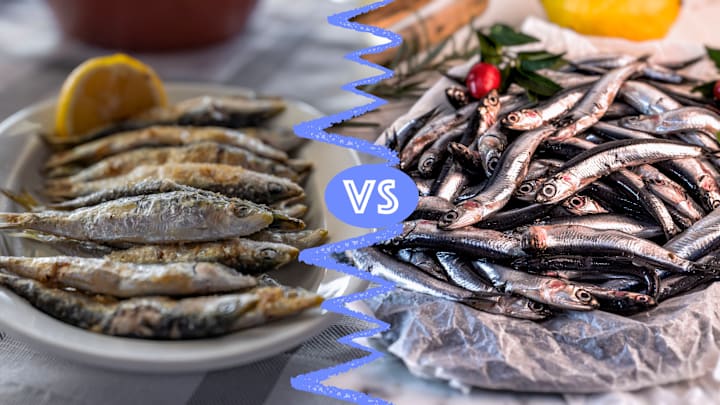While sardines and anchovies often get lumped together, tinned fish aficionados know they’re not the same. Both look similar, but their differences became apparent once you get a closer look (or taste). Whether you’re preparing a Mediterranean-inspired spread or you’re looking to boost your omega-3 intake, here’s how to tell these tiny fish apart.
- Sardines vs. Anchovies: Visual Differences
- Sardine vs. Anchovies: Flavor Differences
- How to Prepare Anchovies and Sardines
Sardines vs. Anchovies: Visual Differences
Lucia Flors and Carlos Leiva, the co-founders of Siesta Co., a Spain-based company that specializes in tinned, organic seafood, explained the differences in a 2022 interview with Food Network.
According to these experts, anchovies tend to be skinnier and smaller compared to sardines. They also have bigger mouths and sport a prominent, silver stripe running along their sides.
Scientifically speaking, both fish are classified differently; sardines belong to the Clupeidae (herring) family, while anchovies are part of the Engraulidae family, which includes various schooling saltwater fish related to herring. There are about 20 species of fish that can be labeled as sardines for consumption, whereas the number of anchovy species is over 100.

Sardine vs. Anchovies: Flavor Differences
Regarding taste, anchovies and sardines are pretty different. Sardines are known for having a flavor profile that’s less fishy and more naturally salty compared to anchovies. Leiva described their taste as being more complex yet mild. Anchovies, meanwhile, have a naturally stronger flavor. Many people are used to eating salt-cured anchovies, which are darker in color and pack a salty kick thanks to their preservation method.
Both types of fish are rich in iron, calcium, proteins, and omega-3 fatty acids. They are also a staple food for many marine species.

How to Prepare Anchovies and Sardines
There isn’t one right way to serve anchovies and sardines. Leiva tells Food Network that both can be served on salads, toast, or even enjoyed straight from the can.
The name sardine derives from the Mediterranean island of Sardinia, where the fish are common. Although sardine families are plentiful in the Mediterranean Sea, they’re also abundant throughout the Atlantic and Pacific Oceans. Anchovies are fished around the world as well.
In the Mediterranean, sardines are often grilled and served topped with olive oil, garlic, and parsley. Anchovies from the region are traditionally salt-cured with olive oil. In Spain, a popular way to prepare anchovies is to bread and fry the fresh fish to compliment their intense flavor.
Many cultures, especially in Southeast Asia, make fish sauces by pressing anchovies, water, salt, and other ingredients. The process results in a deep, umami condiment that pairs well with different proteins, from shrimp to pork.
Read More About Fish:
